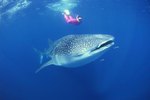
During the latter half of the 20th century, people in the U.S. didn’t have to travel very far to see an Amazon river dolphin. At that time, almost 20 of these dolphins were kept in captivity and put on display at zoos and aquariums across country. Sadly, the last of these captive freshwater dolphins died in 2002. Today, there are only three aquariums in Europe and South America where you can visit and interact with a captive Amazon river dolphin.
Meet the Boto
The Amazon river dolphin, also commonly known as the boto, is one of three species belonging to the Inia family of freshwater river dolphins. He’s both the largest and the most abundant of the three species, which include the La Plata dolphin and the Chinese river dolphin, the latter of which may now be extinct. The boto reaches about 6 1/2 feet in length and has a heavy, bulky body that’s adapted more for maneuverability than for speed. One thing that sets him apart from oceanic dolphins, other than his ability to thrive in fresh water, is a lack of any fused vertebrae, which allows him to turn his head in any direction. This ability to turn and maneuver his body comes in handy in the Amazon river where he often has to navigate around dense vegetation.
Botos in Captivity
Between the late 1950s and early 1970s, several hundred botos were captured and distributed to aquariums throughout the U.S., Europe and Japan. Nearly 100 of them came to U.S. aquariums, and of that number fewer than 20 were able to adapt and survive in captivity. The last of these was Chuckles, a boto who resided for 32 years at the Pittsburg Zoo until he passed away in 2002. In September 2013, only three zoos and aquariums still house captive Amazon river dolphins: Zoo Duisburg in Germany, Aquario di Valencia in Spain and Zoologico de Guistochoca in Peru.
Reasons for Captivity
Keeping river dolphins and other cetaceans in captivity is controversial. Arguments in favor of captivity include the fact that captive dolphins raise public awareness of their plight. The opportunity for people to view these animals up close and interact with them generates popular interest that helps conservationists get laws passed that protect dolphins in the wild. Another argument for captivity is the possibility of breeding endangered dolphins to preserve their population numbers -- Amazon river dolphins were once considered a threatened species, but they're currently not classified as such while researchers evaluate their numbers. Captive dolphins also make it possible to conduct research and gather information on their behavior and habits that wouldn’t be possible with wild dolphins.
Opposition to Captivity
Opponents of keeping dolphins and whales in captivity worry about the health, safety and emotional well-being of the animals. They worry that putting such intelligent creatures on display and forcing them to perform for audiences is degrading and exploitative. They also worry about poor facilities that don’t properly care for the animals, resulting in dolphins who are bored, out of shape and undernourished. Critics also question the accuracy and validity of research done on captive dolphins and whether the results can be applied to dolphins in the wild.
References
Photo Credits
-
Medioimages/Photodisc/Photodisc/Getty Images
Writer Bio
Jean Marie Bauhaus has been writing about a wide range of topics since 2000. Her articles have appeared on a number of popular websites, and she is also the author of two urban fantasy novels. She has a Bachelor of Science in social science from Rogers State University.




